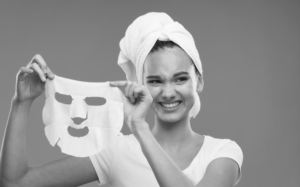Looking to improve the appearance of your skin or give your routine a boost? Do you have an upcoming special occasion that requires putting your best face forward? Are you looking for an affordable at home spa experience? Clay masks and sheet masks are popular skincare options for all the above and more, but they encompass key differences in terms of their formulations, application, and benefits. Find your way to luminous skin by choosing a formula that is right for you.

Formulation:
Clay masks are typically made from natural clays like kaolin, bentonite, or Rhassoul clay, which are mixed with water and other ingredients to create a paste. They may also contain additional ingredients such as botanical extracts, vitamins, or essential oils, depending on the specific formulation.
Sheet masks consist of a thin sheet or cloth soaked in a liquid or serum-based solution. The solution usually contains a wide range of ingredients, including hydrating compounds like hyaluronic acid, vitamins, antioxidants, and other skincare actives.
Application:
Clay masks are applied directly to the face in a thick layer and left to dry for a specified amount of time. As the mask dries, it tightens on the skin and can be rinsed off with water and or a damp face cloth.
Sheet masks are pre-cut and have cut out openings for the eyes, nose, and mouth. They are applied to the face like a second skin and left on for a set period (typically 15-20 minutes) to allow the skin to absorb the serum. There is no need to rinse off the serum after using a sheet mask and the remaining product can be massaged into the skin.
Benefits:
Clay masks are amazing for drawing out impurities, dirt, and excess oil from the skin’s surface and pores. The clay in the mask acts like a magnet, binding to impurities and helping unclog pores. This deep cleansing action can leave skin feeling refreshed and looking clearer.
The tautening and toning effect of clay can help reduce the appearance of enlarged pores and provide a temporary skin-tightening effect. This can result in a more youthful and refreshed appearance.
Many clay masks also contain fine particles that provide a gentle exfoliation when you apply and remove. Manual exfoliation during removal helps to remove dead skin cells, promoting a smoother and brighter complexion. Regular use can improve the texture and tone of your skin over time.
They are also particularly beneficial for people with oily or combination skin. They can help to absorb excess oil, which can lead to fewer breakouts, a reduction in the appearance of pores and an improved overall appearance.
 Sheet masks are often used for their hydrating properties, as they deliver a concentrated dose of moisture to the skin. Added hydration can temporarily plump the skin and reduce the appearance of fine lines.
Sheet masks are often used for their hydrating properties, as they deliver a concentrated dose of moisture to the skin. Added hydration can temporarily plump the skin and reduce the appearance of fine lines.
This type of mask can also have a nourishing effect on the skin. Depending on the ingredients, they can provide various benefits, such as brightening, firming, or soothing the skin. They are easy to use and mess-free, making them a quick convenient option for skincare.
What type is right for your skin type?
Oily or Acne-Prone Skin: If you have oily or acne-prone skin, try a clay mask up to 2 times a week to help control excess oil, unclog pores, and prevent breakouts. Using it more frequently may lead to over-drying, so be cautious. Sheet masks are less effective but can soothe irritated and inflamed skin, depending on the ingredients.
Combination Skin: For combination skin, you may benefit from applying a clay mask 1-2 times a week, focusing on the oily areas like the T-zone. Avoid applying the mask to drier areas of your face to prevent over-drying. Sheet masks unfortunately cannot be as easily applied to specific areas only unless the sheet is cut and customized to fit specific areas.
Dry or Sensitive Skin: If you have dry or sensitive skin, it’s essential to be more cautious with clay masks. Using a clay mask less frequently, perhaps once every 1-2 weeks, can help avoid excessive dryness. Consider using a clay mask that is specifically formulated for sensitive skin or contains moisturizing ingredients. Be mindful using sheet masks as well, for they sometimes contain secondary ingredients that can irritate the skin.
Normal Skin: If you have normal skin without any specific concerns, using a clay mask once a week can help maintain your skin’s balance and keep it looking fresh. Sheet masks can also be used to freshen and brighten the complexion.

It’s always a good idea to do a patch test before using any new skincare product or mask, especially if you have sensitive skin, to ensure that you don’t have any adverse reactions. Additionally, be sure to follow the instructions for maximize its benefits and avoid over-drying your skin.
Overall, it appears that clay masks and sheet masks serve different purposes in skincare routines. Clay masks are ideal for deep cleansing and oil control, while sheet masks are great for hydration and delivering specific skincare ingredients. The choice between the two depends on your skin type, concerns, and the results you’re seeking in your skincare routine. Some individuals incorporate both types of masks into their routine for a balanced approach to skincare.
